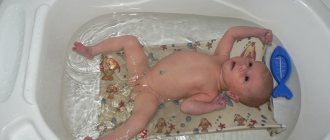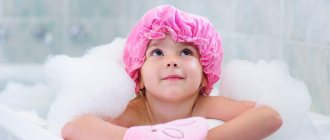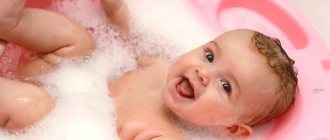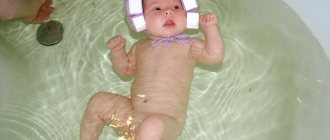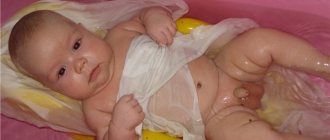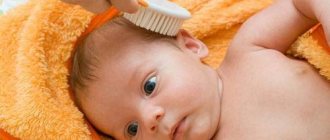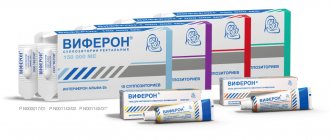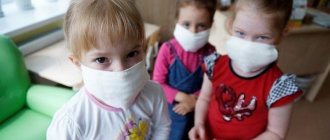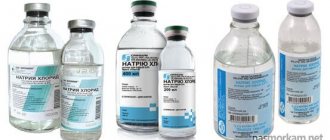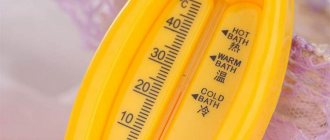Caring for a child raises many questions for parents, some of which require a multifaceted answer. One of the most exciting ones is how and with what to treat. Second in importance: is it possible to bathe a baby with a cold, cough, runny nose, otitis media, conjunctivitis, fever, bronchitis. Let us dwell in more detail on ailments and bathing conditions for them.
Every mother sooner or later faces the issue of bathing a child with a runny nose and other diseases.
The baby is coughing and snotty: should I bathe or not?
The formed belief about the dangers of swimming during ARVI refers to stupid prejudices arising from previous living conditions. Relatively recently, we gave up washing in public baths, where mothers went themselves and took their children with them in any weather. When the windows in the house were old, the cold easily let in, and the air temperature in the apartment depended on the time of year and the quality of heating. A lot has changed today.
Pediatricians say that bathing with a cough or runny nose is not dangerous or harmful, but is very beneficial for the child. An important hygiene procedure helps the small body recover faster. Warm water and soap have a beneficial effect on the skin. Germs are destroyed, pores open, the body breathes, and the baby feels better. The skin is cleansed of irritating sweat secretions, oxygen saturation occurs, and the severity of the cold is reduced. The baby falls asleep more calmly, headaches go away, and the overall tone of the body increases.
How to bathe at high temperatures?
Once you are sure that your child has a high temperature, you should take precautions while bathing. The baby should not be placed in a bathtub filled with hot water. Overheating will serve as a provoking factor, exacerbating the fever. The danger also lies in the occurrence of blood outflow into vital organs, leading to a decrease in pressure. Externally, this condition is expressed in the blanching of the nasolabial triangle.
If your baby has a fever, bathing will have to be postponed until the fever subsides.
5 simple rules will help you avoid problems:
- Start bathing an hour after the child has taken the antipyretic. Before the bath, we measure the baby’s body temperature; it should not be higher than 37.5 degrees.
- We wash the child in the shower without placing him in a bathtub with hot water.
- We heat the water to a temperature that is comfortable for the newborn, when a slight warmth is felt on areas of the body with delicate skin (the sides of the chest and the inner sides of the forearms).
- After finishing bathing, carefully wipe the baby dry. We put him in bed or on the sofa so he can rest.
- After the bath, prepare a drink for your child.
Is it possible to walk with a runny nose?
The decision whether it is possible to walk outside if a child has snot is influenced by several factors. If the deterioration of the condition is caused by a cold, you should pay attention to accompanying signs such as:
- high temperature;
- copious snot discharge;
- cough;
- ailments;
- problems with appetite;
- chills.
Runny nose and swimming
A runny nose is a kind of defense of the body. The inflammatory process in the nasopharynx turns into an impenetrable barrier for harmful microbes, preventing them from passing into the body. However, discharge during rhinitis causes discomfort in the child, since congestion is accompanied by difficulty breathing. It is possible to bathe a baby with a runny nose only if he does not have a high temperature. The procedure does not cause any harm, but you should not heat the room too much. Moderately warm air and a bath facilitate the passage of mucus from the nose.
By inhaling healing vapors, the child will receive home inhalation. The body will cope with snot faster, breathing through the nose will improve, and discomfort during sleep will disappear.
Bathing with herbs will not only cleanse the baby’s skin, but also facilitate the passage of mucus from the nasopharynx
Avoid swimming if you have sinusitis or sinusitis: a hot bath is contraindicated for purulent inflammation of the paranasal sinuses. Complications of the disease with nosebleeds or acute otitis media do not cancel bathing, but the child should be washed according to the same rules as at temperatures above 38 degrees. Take note of them and strictly follow them so as not to worsen the baby’s condition.
Bathing a child during a cold
If a runny nose is a symptom of a cold (only a pediatrician can confirm this), then bathing the child is not recommended until complete recovery. Although some doctors, for example, the well-known Dr. Komarovsky, express the opinion that if a child’s temperature is not higher than 37.2 ° C, then he can be completely washed, provided that the water in the font is 2-3 degrees higher than usual. Again, they emphasize that after bathing the baby, you need to immediately wipe him dry and dress him on the spot.
But this approach is not entirely correct, other experts say. Colds are often caused by infection or harmful bacteria. When bathing a child, his body steams, blood circulates faster and actively spreads viruses throughout the body. In addition, during an illness the child is weakened, he feels bad, although he cannot complain, but he has a headache, his arms and legs are twisting, he has no appetite, maybe he feels nauseous, everything is the same as in an adult. Therefore, bathing will not bring joy to a sick baby; it will only tire him and further weaken his immune system. It’s not for nothing that our grandmothers warn that a baby with a cold does not need to be bathed.
However, no one cancels hygiene procedures even during a cold. The child must be washed regularly, wash his face, clear his snotty nose, wipe his palms and feet with a towel moistened with warm water.
How to bathe a baby when he coughs?
When answering the question of whether it is possible to bathe a child with a cough, do not forget about the reasons that caused this illness (we recommend reading: how to bathe a child correctly?). In addition, we take into account the general well-being of the baby. Dr. Komarovsky advises not to interrupt the water procedures, but to choose the right washing mode.
- Adenoiditis or viral runny nose - the rules for bathing are identical to those prescribed above for fever and ARVI (see also: acute adenoiditis in children: symptoms and treatment).
- Cough caused by regurgitation during gastroesophageal reflux is not a contraindication to bathing. On the contrary, doctors recommend bathing a child by adding healing infusions to the water. This procedure is also useful for neurotic cough.
- A dry, “barking” cough in an infant signals acute laryngitis, which causes swelling of the vocal cords. A bath can intensify it and worsen the course of the disease. It is more useful for a child to do ultrasonic inhalations, allowing him to breathe cool, moist air. Postpone taking a bath for a few days.
- Bronchitis and acute tracheitis - a warm shower to maintain the child’s hygiene (we recommend reading: acute tracheitis in children: symptoms and treatment). The wet nature of the cough with bronchitis allows you to bathe the baby in a warm bath. Add healing decoctions of wild rosemary, sage, thyme, and plantain to the water. Wheezing, shortness of breath, whistling in the bronchi warn that you should not wash in hot water.
- In case of pneumonia, bathing is postponed until the child’s well-being noticeably improves. The disease is accompanied by high fever, cough, and shortness of breath. Replace washing with wiping with a damp towel. Having passed the crisis threshold, you can rinse your baby in the shower. During the recovery phase, bathing in a sitting position is allowed.
Contraindications to water procedures with a runny nose
Why does bloody diarrhea occur in a child under one year old?
Parents whose children have been swimming with an instructor from a young age are wondering whether it is possible to bathe a baby in the pool with a runny nose without a fever. A clear contraindication would be allergic rhinitis. This is due to the fact that almost all swimming pools use chlorine to disinfect water, which will become an additional irritant to the mucous membranes of the respiratory tract. First, you should visit an allergist, who will give his opinion regarding visiting the pool.
Important! If a family regularly visits the bathhouse, it is important to know that overheating is contraindicated for a child under three years of age. In the bodies of children of this age, thermoregulation processes occur differently than in adults. Therefore, high ambient temperatures are dangerous for babies.
Bath for conjunctivitis
Inflammation of the conjunctiva, not aggravated by the poor health of the daughter or son in general, does not prohibit taking a warm bath. If conjunctivitis appears against the background of an acute respiratory viral infection, bathe your baby in the same way as we described earlier. After finishing the water treatments, start treating conjunctivitis. Wipe your baby's eyes with a damp cotton pad dipped in boiled water. Apply liquid drops or treat the lower eyelid with ointment that helps with conjunctivitis.
Children tend to catch colds often. Preschool children regularly cough, are filled with snot, and suffer from diathesis (see also: what to do if a child coughs while sleeping?). By being careful with bathing or refusing it during illness, you add dirt to your cold, and with it germs. Use our tips, and water will help you get rid of germs and viruses, and give your child relief and pleasure. Temper your baby, and then the question of bathing with bronchitis or conjunctivitis will lose its relevance.
The arrival of a new family member in the home is inevitably associated with many difficulties and worries. And, of course, every adult has his own ideas about how to properly treat children, what they can and cannot do. Unfortunately, when tested, many of these opinions turn out to be completely unreliable or outdated.
For example, some parents and grandparents believe that bathing can harm the baby if he has a runny nose. But in the conditions of a heated apartment or a comfortable house, where it is not difficult to maintain comfortable warmth, there are no compelling reasons for such a point of view.
Colds in summer: how to treat a child?
So, having figured out why people get colds in the summer, you need to remember that if your baby experiences any alarming symptoms, you should definitely consult a doctor. Only a specialist, based on data about the child’s condition, can prescribe the optimal course of therapy.
THIS IS INTERESTING!
A cold is dangerous because it may not manifest itself in any way during the incubation period. This is approximately 36-48 hours from the moment of contact with a cold person until the first symptoms appear. Moreover, during the incubation period, the activity of the virus remains, and an infected person can become a spreader of the disease without even suspecting it.
Before consulting with a specialist, parents can also take some measures to alleviate the child’s condition and treat summer colds. The list of recommendations is quite simple:
- When a child is sick with ARVI or flu in the summer, you need to provide him with a sufficient amount of warm drink. This way, you will be able to avoid dehydration of the body and at the same time remove toxins that are formed as a result of the activity of viruses and bacteria. It will be great if you use seasonal fruits and berries to relieve cold symptoms in the summer - these are excellent fortified ingredients for making homemade compotes and fruit drinks.
- Do not deprive your baby of walks in the fresh air, but make sure that he does not overheat under the rays of the summer sun. Therefore, it is recommended to take walks in the morning (before 11 o’clock in the afternoon) and in the evening (after 16 o’clock).
- A good and timeless way to treat a summer cold is to gargle frequently. This will help moisturize the mucous membrane, remove bacteria and viruses from its surface, and also promote its faster recovery.
- Finally, it's worth considering indoor air humidification. In the summer, due to air conditioning in apartments, air humidity decreases, which leads to overdrying of the nasopharyngeal mucosa and its damage. To exclude this, you can buy a separate humidifier or simply install water containers in your rooms (for example, an aquarium or flowers in vases).
Causes of a runny nose
A runny nose in a baby is a very common phenomenon and can have various causes. An experienced pediatrician can install them most reliably. If we are talking about the physiological runny nose of newborns, then this is the natural state of the child in the first few months after birth. It does not prevent the baby from feeling well and breathing relatively freely; there is no fever or cough. In this case, sacrificing hygiene for the sake of prejudice is completely pointless.
Even if a runny nose is caused by bacteria or viruses, it will still not be possible to avoid water procedures , because the baby will recover for several days. Therefore, it is recommended to refrain from bathing only if the child is really unwell: elevated temperature, other severe symptoms and noticeably deteriorated physiological condition. In this case, a full bath in the bath should be replaced with quick rinsing and rubbing, and try not to get your hair wet.
To swim or not to swim – how relevant is this question?
In fact, the problem with swimming when you have a runny nose is overblown. Worried parents tear pediatricians away from TV in the evenings, and especially restless patients rack their brains for several days to determine whether water procedures will lead to an exacerbation of the disease.
So, the process of bathing itself has no effect on a runny nose. The fact that a person wets himself, soaps his body and washes off the soap, the nasal mucosa will not notice. This is true for both adults and children.
Simply put, the body with rhinitis is absolutely indifferent whether the act of washing the body occurs or not. This is important only for the person himself who wants to be clean and smell good. This is even more important for parents of a snotty child: when bathing and splashing water in the baby, the snot softens, liquefies, and water entering the nose causes natural sneezing and the removal of a large amount of mucus. For a runny nose, this effect is very useful: the mother then does not have to torment the child with an aspirator or bulb.
This means that if you want to wash when you have a runny nose, you can do it. You can also bathe the child if circumstances require it (see example in the photo below).
This is the case when you have to swim regardless of the presence of a runny nose and the wishes of the parents.
And vice versa: if there is no desire to get into the bath or take a shower, then you can safely not do it. And you can also safely not bathe a child with snot if he categorically does not want to bathe.
Children and adults can take water procedures for a runny nose of any nature:
- With obvious signs of ARVI, even when the patient has a slightly elevated temperature. Warming the body in warm (not hot!) water will be useful in this case. The effect of moist air in the bathroom on the nasal mucosa will also be useful;
- In the recovery phase after an illness, when there is no longer a fever, and only snot and cough remain.
The parainfluenza viral particle is a common culprit of acute infectious rhinitis.
All this is true for a simple home bath in water at a comfortable temperature and lasting about 10-15 minutes. At the same time, some types of bathing with a runny nose are not recommended.
It is also useful to read: Why does constant runny nose and sneezing occur?
Safety first
In other cases, not associated with a significant deterioration in well-being, the child may well splash around in the bathroom even if he has a runny nose. It is only important to follow some rules to make swimming as safe as possible:
Make sure the water is warm, but not hot, before you start bathing. The range of 35-38 °C will be just right. For an adult, such a bath may seem a little cold, but it is at this temperature that the child is accustomed to being during his stay in his mother’s belly. But hotter water can cause increased heart rate and overheating. So advice to thoroughly “steam” a baby in the bathroom can confidently be classified as harmful. If your baby's skin turns red, it means that next time you will need to pour cooler water.
By the way, it is recommended to bathe a newborn baby in boiled water for the reason that his navel has not yet healed. Usually the wound heals within 10-14 days .
- Before you start water procedures, make sure that you have everything you need for bathing and subsequent changing at hand: towels, toiletries, a clean diaper, clothes.
- Don’t get carried away: 5-8 minutes is more than enough to bathe your baby. Carefully monitor his condition and end baths if the child shows fatigue or is capricious.
- Do not plan bathing for a time after eating or drinking heavily - this will tire the child and may even make him sick. It is best to wait at least an hour after eating. The same goes for taking medications.
- You can add a little sea salt or decoctions of medicinal herbs to the bathing water - chamomile, calendula, string, etc. It will be useful to consult a doctor about the composition of herbal teas to take into account the possibility of allergies and the individual characteristics of the baby.
In general, the effect of inhalation helps strengthen the immune system and will have an anti-inflammatory effect. In addition, the aromas of the sea or herbs will make bathing a more pleasant experience for both the child and his parents. They will have a calming effect and help the baby fall asleep quickly.
Maintaining the water temperature while bathing your baby is good, but not enough. The mechanism of thermoregulation at such a young age is still poorly developed. Therefore, after water procedures, the child can quickly lose heat and freeze. Therefore, immediately after bathing, use a towel, dry and dress your baby. You should cover your head with a cap or hood, and put socks on your feet.
Make sure that during and after washing the air temperature in the bathroom and bedroom is as comfortable as possible and that there are no drafts. The air conditioner and fan should be turned off, windows and vents should be closed tightly.
Bathing is not only a necessary hygienic procedure, but also an opportunity for a parent to calmly communicate and strengthen the bond with the child . And like a massage, a warm bath can be a great soothing ritual to get your little one ready for bedtime.
The birth of a newborn child is accompanied by the emergence of many questions among young parents. A newborn baby is not protected from the effects of adverse environmental factors, which is due to the immaturity of the immune system.
During the first months of life, infants suffer from infectious and colds, which are accompanied by fever, cough, runny nose and general malaise. If the baby is sick and is bothered by a runny nose and cough, then parents will be interested in the possibility of bathing the baby, provided that the child does not have an elevated body temperature.
Swimming with a runny nose
If a runny nose is the only symptom that appears, nothing prevents parents from bathing their child. But before starting the procedure, it is worth taking your temperature. If this indicator does not exceed 37 degrees, then there are no restrictions on water procedures.
If all precautions are taken, bathing will be beneficial, even if the runny nose is of a cold nature. If the disease is accompanied by sweating, microbes and toxins are released through the skin. Therefore, ensuring body cleanliness allows you to reduce the number of pathogenic microflora, which leads to improved well-being.
General provisions
The maturation of a child’s immune system occurs no earlier than 6 months from birth. Until this time, the immune protection of the child’s body occurs due to the ingestion of immune cells from mother’s milk. Cough and mucous discharge from the nasal passages are characteristic not only of colds, but also of allergic reactions. A distinctive feature is that with allergies the body temperature does not increase.
The following factors can provoke cough and nasal congestion without an increase in body temperature:
- Chronic rhinitis;
- Inflammation of the sinuses and nasal passages (sinusitis);
- Nasopharyngitis, characterized by inflammation of the middle ear, nasopharynx, and paranasal sinuses;
- Pharyngitis;
- Laryngitis;
- The so-called allergic bronchitis.
To identify the exact cause of this condition, the baby must undergo a comprehensive examination, including bacteriological culture from the nasopharynx and allergy tests.
Is it possible to bathe
Hygiene procedures are an integral part of the care plan for a newborn baby. If the child’s body temperature does not rise against the background of a cough and runny nose, then it is not prohibited to buy the baby. In this case, the following rules are observed:
- To bathe a newborn, use boiled water, to which decoctions of chamomile or string are added in advance;
- It is strictly forbidden to use hot water to bathe a baby. Regardless of whether the child's body temperature is elevated, hot water will not be beneficial. The optimal temperature for swimming is no more than 38 degrees;
- At the end of the hygiene procedures, the child’s body is wiped dry, placed in a crib and covered with a not too warm blanket.
If a baby has an allergic cough and runny nose, then daily bathing will not have a negative impact on the child’s general condition. If the cause of the illness is the development of a respiratory viral infection, then swimming is allowed until the body temperature rises.
This procedure will reduce swelling of the nasal mucosa, clear the upper respiratory tract of accumulated mucus, and also accelerate the removal of toxins and waste from the body. When bathing a newborn, you should pay attention to his condition and behavior. If the baby has become capricious, lethargic and whiny, then he must be removed from the bath, wiped dry, put in a crib and body temperature measured.
What is a runny nose? Types of runny nose
A runny nose is a physiological condition of the body in which mucus is released abundantly from the nasal passages, the passages themselves swell, blocking the access of air, which, coupled with mucous secretions, becomes the main cause of nasal congestion and inability to breathe. What causes a runny nose in a newborn?
There are three main reasons:
- the natural physiological state of an infant up to 3 months of age. Such rhinitis goes away on its own within 3 months, more often earlier, does not pose any threat to the child’s health, and is associated with physiological processes and adaptation of the child’s body to new living conditions. Characterized by rare discharge of light, thin mucus from the nose;
- allergy. With this reaction the body responds to various irritants: dust, indoor flowers, soft toys, household chemicals, natural carpet pile, animal hair and their food, nutritional mixtures, herbal decoctions, etc. Anything can trigger the appearance of an allergic runny nose if a newborn has such a condition. predisposition. Symptoms include clear, weak nasal discharge, tears, sneezing, redness of the eyes and nose. Allergic rhinitis must be kept under control to prevent complications such as asthma and suffocation. How to get rid of such a runny nose? First of all, you need to find and remove the allergen away from the child, and be sure to give the baby antihistamine drops. Fenistil has proven itself well;
- cold. If a child is hypothermic, a bacterial or viral infection enters his body, then a cold develops, the common symptoms of which are a runny nose, cough, wheezing, headache, fever, loss of appetite, sleep disturbances, and irregular bowel movements. Nasal discharge during a cold has its own characteristics: at first the sniffles are transparent, liquid and abundant, then they become thick and greenish-yellow, preventing the child from breathing, causing him severe discomfort.
The answer to the question whether it is possible to bathe a baby with a runny nose depends on what type of rhinitis the baby suffers from.
